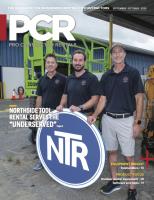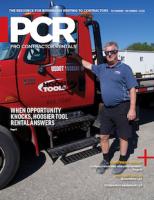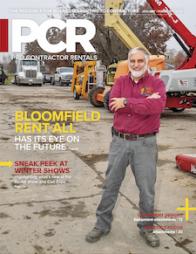Five equipment manufacturing trends to watch in 2022
The immediate and long-term future of the equipment manufacturing industry will be defined by five trends, Associated Equipment Manufacturers (AEM) experts report.
It's critically important for equipment manufacturers to develop a keen understanding of these trends and how they will evolve over time. Perhaps most importantly, however, those within the industry must be able to assess their impact on equipment manufacturing and the customers it serves.
1. Workforce challenges and solution
When it comes to the workforce, 2021 has proven that doing what we’ve always done will no longer get us what we used to get, says Julie Davis, AEM senior director of Workforce and Industry Initiatives
Demographic research shows that employment challenges are not going to return to what they have been pre-pandemic. If anything, the pandemic acted as an accelerator that took labor force trends already sneaking up on the industry and exploded them into a new reality.
The most significant trends include the shift from a baby boomer pre-pandemic drift toward retirement to a pandemic mass exodus of retirements. Second, a labor force participation rate that was declining since 1980 dropped to record lows with 2.4 million women leaving the workforce, fewer millennials seeking careers of their own, working age males increasingly preferring part-time over full-time work, and an opioid epidemic siphoning off prime-age men by the hundreds of thousands per year. Finally, the U.S. birthrate has been steadily declining, hitting a 35-year low in 2019, according to census data. With fewer people available, the labor market will continue to tighten. Immigration is not a solution, because the same decline in birth rate is happening in countries that have been sources of immigrant labor in th epast.
If your HR department says it is doing everything they can, consider it a red flag. Successful HR departments continuously evaluate and offer competitive compensation, provide meaningful benefits, offer potential career development opportunities and, most of all, flexible work schedules. The employee experience needs to be reconsidered, much like how customers have analyzed the customer experience in the past. Important considerations include:
- Streamlining the application process
- Meaningful onboarding
- Mental health supports
- Opportunities for upskilling
- Internal career path or debt-free education
In addition, hourly workers want flexibility, even if they must show up in person. Creative companies are finding ways to provide flexibility and predictability in scheduling to support health and wellness, childcare and caregiving responsibilities, David says.
2. Bipartisanship
At the close of 2021, federal lawmakers delivered a long-awaited holiday gift to the American people – the passage of the Infrastructure Investment and Jobs Act, also known as the Bipartisan Infrastructure Bill, says Kip Eideberg, AEM senior vice president of Government and Industry Relations.
While many were elated at the congressional approval and enactment of the bill, there are many who are frustrated and disillusioned with the time it took to get the job done. The unnecessarily drawn-out and overly political infrastructure debate spells trouble for our country. So what can be done to end the petty partisan squabbling during a critically important election year? One word: bipartisanship.
While the infrastructure bill has been signed into law, much work remains to be done. It is up to U.S. Secretary of Transportation Pete Buttigieg and President Biden’s recently appointed infrastructure czar, the former mayor of New Orleans, Mitch Landrieu, to work with state and local governments to ensure the successful implementation of the $1.2 trillion bill.
The work doesn’t stop at infrastructure. Elected officials at the state and federal level must put policy ahead of politics and advance pro-growth economic policies that will ensure the long-term growth and prosperity of the equipment manufacturing industry, Eideberg says. Lawmakers must also make investments to help attract, train and retain the next generation of skilled workers to address our industry’s growing workforce needs. Finally, the country needs commonsense policies that will help revitalize American manufacturing, bolster rural communities and reenergize the U.S. economy.
3. Supply chain management
In 2021, off-road, heavy-duty equipment industry stakeholders found themselves dealing with a relatively new concept for U.S. manufacturers: chemical management issues, says Jason Malcore, AEM director of Global Standards and Compliance.
On January 6, 2021, the EPA announced its Final Rule regarding the prohibition on introducing Phenol, Isopropylated, phosphate (3:1) into commerce. This ban on a commonly used flame retardant struck the equipment manufacturing industry especially hard. Overnight, a wide swath of companies needed to rewire their manufacturing and design processes and perhaps most importantly, learn how to manage a wide-ranging, deep and complex global supply chain not familiar with the needs of tracking chemical components.
Managing supply chains, communicating chemical requirements, educating suppliers and managing data will be the only way to meet the coming challenges. With the size and complexity of the global off-road, heavy-duty equipment manufacturing industry, meeting this challenge will be an enormous task. To achieve this goal, industry stakeholders will need to work together to establish new industry best practices and efficient lines of communication to ensure information can effectively travel from one end of the supply chain to the OEMs. The industry has not yet found all the answers, but this will be a very important issue for 2022 and beyond, Malcore says.
4. COVID-19 and employee safety
In 2022, COVID-19 continues to have a significant impact on the manufacturing industry, says Sara Feuling, AEM senior director of Construction. While health and safety protocols and best practices have been developed to combat the virus, COVID-19 has done what viruses do best – change and evolve.
Thankfully, the manufacturing industry continues to change and evolve right along with it, adapting to new CDC guidelines, OSHA regulations and local mask and vaccine mandates to keep business owners and their employees safe.
The last two years proves equipment manufacturing industry remains strong and resilient, even in times of tremendous uncertainty. The pandemic has affected the way businesses operate, the economic outlook, the supply chain and most importantly, the workforce.
All this change will eventually come to an end, but until that happens, the industry will need to keep adapting to keep workers safe.
5. Leveraging data for better decisions and traceability in agriculture
Now more than ever, farmers are operating on the notion of doing more with less, says Austin Gellings, AEM Agriculture Services manager. This is because they must deal with resource constraints and increasing societal pressures.
As AEM showed early in 2021 with the release of the Environmental Benefits of Precision Ag Study, technology has brought us a long way and still leaves much room to grow.Data is the key to accomplishing this goal even further.
Data enables farmers to make better decisions for the year based on the 4R principle of right rate, right place, right time, and right source. Farmers have been doing this for years, but with costs of fertilizer and other on-farm inputs on the rise, utilization of this data has never been more important. It can also help provide input into other areas of the farm to increase efficiencies there as well, says Gellings. .










